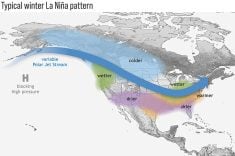Linda Vogel pauses when yet another reporter asks her to tell the story of how her daughter got sick from contaminated water.
The farm mom pauses, but says yes.
Talking to reporters is what Vogel does to raise awareness about the state of drinking water in southern Alberta.
“She’s better,” said Vogel, but it will be at least a week before the family will know if there is permanent kidney damage.
Health officials have confirmed that Vogel’s six-year-old daughter Caylee became sick from the same deadly strain of E. coli bacteria that killed six people in Walkerton, Ont., earlier this year.
Read Also

Canadian Food Inspection Agency extends chronic wasting disease control program consultation deadline
Date extended for consultation period of changes to CWD program
And as in Walkerton, Vogel is pointing to nearby cattle as the likely source of water contamination. Vogel lives in the heart of “feedlot alley,” the area in southwestern Alberta where large numbers of cattle are fed.
“We’re inundated with heavy, heavy livestock,” said Vogel, who opposes feedlot expansion. “We’re not trying to control it, but we want to avoid further development.”
The family buys bottled water to drink, hauls treated water for bathing and cooking and pumps water from a nearby irrigation ditch for watering the garden and lawn.
Untreated water
Vogel believes her daughter got sick from eating raspberries and peas that had been irrigated with untreated ditch water.
“Everything points to there. There is absolutely nothing else,” said Vogel.
“They were in the garden for three days in a row eating raspberries and breaking apart the pea pods.”
Health officials say she may be right.
“There is a distinct possibility that’s how the E. coli was deposited on the vegetables the young girl ate,” said Brian Dalshaug, director of health protection for the Chinook Health Region.
“You can’t rule out actually saying feedlots caused the problem. It’s a bit premature, but it’s highly suspicious.
“Any surface water used for human consumption is not safe to drink,” he said.
“Rural folks using water not treated are putting themselves at risk.”
Soil samples have been taken from around the garden to check for the presence of E. coli.
Since the end of May, 26 cases of E. coli illness have been confirmed in the area. That’s a “little above average” for the time of year, and higher than the provincial average, said Dalshaug.
Some cases were from eating undercooked meat, drinking unpasteurized milk or dugout water, while others occurred on holidays in the mountains or were caused by eating contaminated food.
About half the cases were in the city of Lethbridge and the rest in farms and rural communities. Some were the deadly E. coli 0:157. Others were not.
Dalshaug said the only way to ensure safe water is to have it tested and to make sure a proper treatment system is in place and working. He has heard several stories of rural residents installing faulty water filtration systems or residents not knowing they need to regularly maintain their filtration systems.
“We’ve had all kinds of horror stories of unscrupulous salesmen.”
Dalshaug also lays part of the blame on the provincial government for not approving regulations for intensive livestock.
The Chinook Health Region is still lobbying the province to implement the regulations.
“A lot of effort went into the regulations and for whatever reasons, it was put on the backburner and it’s still left up to the municipalities to regulate the expansion.”














